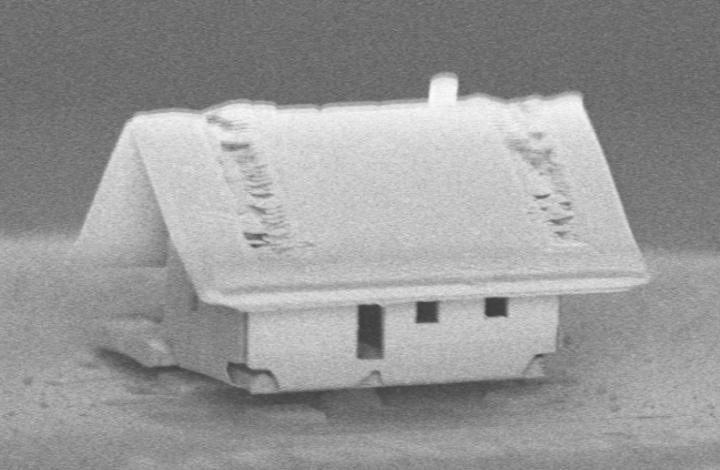May 23 2018
A novel microrobotics system, assembled by a French nanorobotics team at the Femto-ST Institute in Besançon, France, pushes the limits of optical nanotechnologies.
 A microhouse’s tiled roof shows the ion gun’s new ability to focus on a 300-by-300-micrometer area. (Image credit: FEMTO-ST Institute)
A microhouse’s tiled roof shows the ion gun’s new ability to focus on a 300-by-300-micrometer area. (Image credit: FEMTO-ST Institute)
The µRobotex nanofactory, integrating a number of current technologies, constructs tiny structures in a huge vacuum chamber, and with nanometer precision attaches components onto optical fiber tips. The innovative microhouse construction has been featured in the Journal of Vacuum Science and Technology A, from AIP Publishing, and shows how scientists can improve optical sensing technologies when they exploit electron beams, ion guns, and finely controlled robotic piloting.
To date, no robotic actuators were included in lab-on-fiber technologies for nanoassembly, and therefore working at this scale prevented engineers from constructing microstructures. Now, this latest innovation makes it possible to install miniaturized sensing elements on fiber tips, allowing engineers to view and exploit various components. Thanks to this development, optical fibers as thin as human hair can possibly be integrated into inaccessible locations like blood vessels and jet engines to detect viral molecules or radiation levels.
For the first time we were able to realize patterning and assembly with less than 2 nanometers of accuracy, which is a very important result for the robotics and optical community.
Jean-Yves Rauch, Author
Whit a single vacuum chamber, the French engineers integrated all the technological components for nanoassembly such as a gas injection system, a focused ion beam, and a small maneuverable robot, and also installed a microscope to observe the assembly process. “We decided to build the microhouse on the fiber to show that we are able to realize these microsystem assemblies on top of an optical fiber with high accuracy,” Rauch said.
Although constructing a microhouse is similar to creating a massive dice from a piece of paper, nanoassembly calls for more advanced tools. First, the focused ion beam is utilized like scissors to score or cut the silica membrane “paper” of the house. Then, after the walls fold into position, a lower power setting is chosen on the ion gun and the gas injection system fixes the structure’s edges into place. Finally, the gas injection and low-power ion beam gently sputters a tiled pattern on the roof—a detail that underscores the system’s flexibility and accuracy.
During this process, the ion gun had to concentrate on a section that measures just 300 micrometers by 300 micrometers so as to fire ions onto the silica membrane and fiber tip.
“It’s very challenging to pilot the robot with high accuracy at this cross point between the two beams,” said Rauch. He elaborated that two engineers controlled the process by working at multiple computers. While several steps are already automated, the engineers are hoping to automate all the robotic stages of assembly in the future.
With the help of the µRobotex system, the nanorobotics team is now building functionalized microstructures to locate particular molecules by fixing their microstructures onto optical fibers. By building smaller structures and attaching these onto carbon nanotubes, which measure just 20 nanometers to 100 nanometers in diameter, the engineers hope to push the limits of the technology even further.